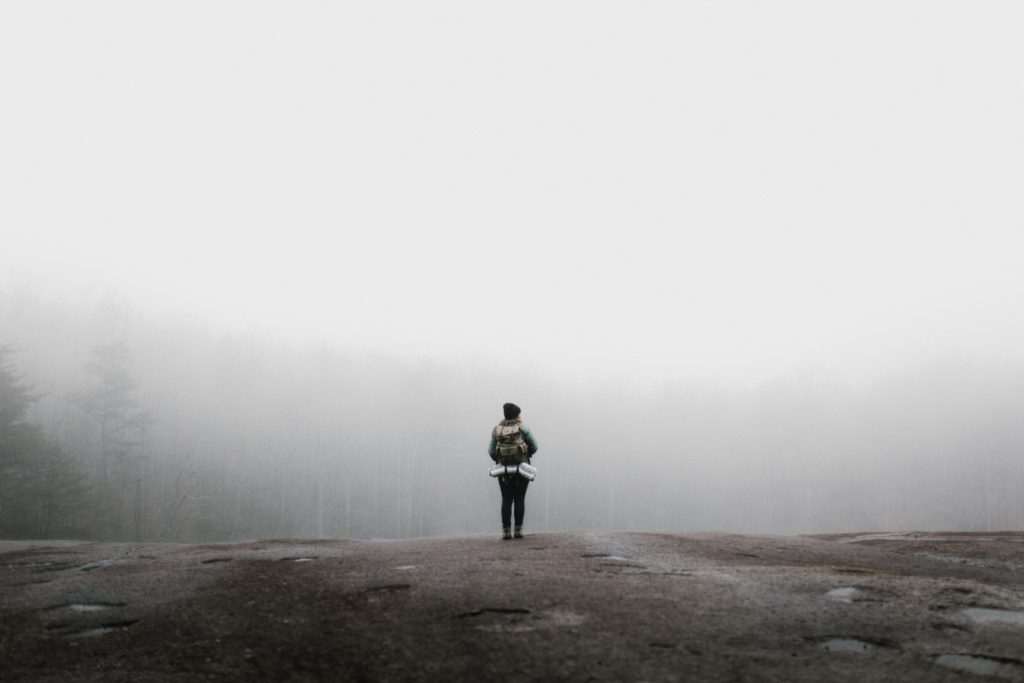The Nature of Culture: Moving Beyond Binaries
The meeting point between nature and culture is place. Human beings’ destructiveness as a species comes from our discomfort with placelessness. Without feeling the belongingness of being human in the world, not only are we collectively challenged in caring for ourselves as a species, some of us may also feel guilty for being part of a group that continuously destroys the lives and habitats of other humans and species.
This post is an excerpt, with edits, from Chapter 3 of my PhD Dissertation “Nature, Self, and Being in the World.”
Guilt for landscapes
I had at one time felt guilty for adoring landscape images. A quote on the wall by Indigenous art scholar Jolene Rickard at the Art Gallery of Ontario’s exhibit Picturing the Americas: Landscape Painting from Tierra del Fuego to the Arctic (2015) was the presumption of my guilt. It said: “From an Indigenous perspective, the genre of landscape painting is one of conceptual and visceral tools of colonization.”
A year before the exhibit, I had returned to school after working as a landscape architect for seven years. As a masters student in humanities, I was reading for the first time academic literature on post-colonial and critical landscape studies (i.e., the works of Edward Said, Gayatri Chakravorty Spivak, Alexander Wilson, Bruce Braun, and William Cronon). As a romantic-at-heart, an idealist, a landscape photography and painting admirer, and a landscape architect, I learned that I was in every way guilty of being a contemporary “colonialist.”
While these writers’ goals were likely not to intentionally make readers guilty but to bring attention to colonialism and its unresolved social and ecological wounds, I had felt, through their words, that I was supposed to feel guilty for admiring the beauty of landscapes because viewing nature from a nostalgic perspective or to “romanticise nature” was somehow a sign of “evil” colonial-based thinking.
Accordingly, I felt that I was supposed to feel guilty because I had benefited from the atrocities made by past human civilisations.
A need to reconcile guilt
While the guilt was uncomfortable, the biggest dilemma was that my life-time enchantment with landscapes was up for trial. Fortunately, I ended up reconciling those feelings of guilt. I fully acknowledge that landscape images were formative to how I connect with the sacredness of nature and that the beauty I experience through two- and three-dimensional landscapes has helped me understand the sacredness of humanity.
I do not want to claim that post-colonial and critical landscape studies are inherently shaming, but for me, they need to be studied in tandem with something else that is antidotal towards any disenchantment of life that these studies may bring. To start a practice of re-enchantment, we need to see nature and culture as parts of the world’s processes.
Natural aliens that don’t belong
Between nature and culture is place. But ironically, placelessness is part of human nature. According to Neil Evernden (1985), we are somewhat “natural aliens” on this planet because of our evolutionary characteristics.
First, our development pattern is unique compared to other vertebrates. Vertebrates generally produce either nidiculous offspring that are immature at birth and nest for long periods, or nidifugous offspring that have open eyes and are aware of the world at birth. Youthfulness in vertebrates, according to Dutch psychologist Frederik Buytendijk, is typically characterized by indeterminance, activeness, a pathic mode towards the environment, and an ambiguous “shyness” between home and outside, family and individual.
Humans are neither nidiculous or nidifugous. We are described as secondary nidicolous because we require a unique social gestation period. We have an extensive period of “youthfulness.” Therefore, according to Evernden, “We are […] indeterminate, always in motion, ambivalent, obsessed with the ‘how’ of the world, and uncommitted to an environmental context” (117).
Moreover, as we evolve by developing new tools and technology, we are constantly mutating as a new exotic predator in our environments. Our self-identity is constantly in a state of confusion. This sort of collective identity crisis brings about a desperation to “devise mythologies” as instructions to what behaviours to perform and what destinies to seek (110).
These “mythologies” or narratives of our relationship with our nature, in-turn form our self-identity. For example, when we unceremoniously blame human vices as “human nature” we create a notion that humans are defective, and that nature is also destructive.
Our placelessness becomes a collective lack of belonging—for just being ourselves, as humans in the world. This challenges our ability to fully care for ourselves as a species, and also leads to feelings of guilt (for many of us, consciously or subconsciously) for being part of a group that continuously destroys the lives and habitats of other humans and species.

Seeing culture as part of nature
To recover from placelessness and not-belonging, we need to change the core narrative of our relationship with nature. Instead of seeing nature and humans as separate, we need to see humans as fundamentally part of a greater system of nature. This also means that human flaws need to be considered as “natural” and not defects to be ashamed of.
So if humans are nature, then under logical deduction, culture is also natural. All that is considered human-made, artificial or culturally produced, is then a subset of the wider natural world.
While this makes logical sense, I can imagine the social and ecological criticisms for accepting this perspective. If we accept all that is human as natural, then would we not be dismissing all the destruction produced by human behavior, such as social violence, ecological exploitation, and environmental degradation?
No, because the question is based on a flawed assumption.
A binary judgement has been made with the term “natural”. Within the contemporary mindset, we have an instinctive refusal to accept all of human behaviour, both beneficial and destructive, as natural because within the concept of nature is a psychological association of what is “good.” As long as this mental judgement is maintained, humans either cannot be completely part of nature or we must consider ourselves as natural pests, tragically here on the planet in order to destroy it.
Are we “natural sinners”?
The judgement that pristine nature is “good,” I believe, is not really about nature. Instead, it is a marker of humanity’s self-judgement that humans are “bad.” Although American Transcendentalism in the 1800s did converge the idea of nature with human morality, humanity’s baggage as “sinners” has long been part of our consciousness from the well-known Christian interpretation of our origin story.
Since the word nature is used to describe an “essential quality” or “inherent force,” what’s natural is considered as something that “should be.” So if humanity was destined to be sinful from our first touch on Earth, and sin is considered a fault, then it is easy to believe that we should have never been here from the start!
If this belief of not deserving to belong forms our collective psychological foundation, then any story that reinforces our flaws in a unidirectional way would also easily arouse our dormant shame of being human. For example, post-colonial and critical landscape studies remind us of humanity’s faults but offer little solutions for forgiveness or acceptance. Moreover, the persistent engagement of this self-judgement is a self-defeating narrative.
Moving beyond binaries of good and bad
According to Daoism, moral values of righteousness (i.e., what is “right” or “wrong”) are “ineffective remedies in a degenerative society” (Moeller 2004, 117). By creating the category of goodness, there will always be badness, because the world operates through complementary dualism (i.e., yin and yang). Nature, in Daoism, often translated as “self-so” (ziran), is therefore, not what “should be” but what is the natural path to take. In other words, one’s “own course” without the need of morality (35).
Accordingly, what is natural (self-so) for humanity is the ability to choose actions and choose different narratives. Within this ability is the choice of declining the power of making a choice, although many of us at various times in our lives will not be aware of an available choice and will argue that we “have no choice” instead of saying that we are choosing not to make a choice!
Nevertheless, accompanying each choice that we make are consequences that are within a broad spectrum of advantages and disadvantages. We know that within humanity’s nature is also the (high) probability of making damaging choices or “sins” (from the Christian perspective). Accepting the balance of relative advantageous and disadvantageous actions is part of the Daoist yin and yang ontological system.

Maintaining vs. tending
Not only is a binary approach to evaluating complex human behaviours unproductive, sometimes the results don’t even make sense, especially when we look at how humans treat other natural beings and elements. For instance, a conundrum occurs when we consider the subtle difference between “maintaining” and “tending” to nature. For example, lawn-care and Zen gardening are two different ways of relating to nature, yet they both require deliberate and repetitive attention.
Obsessive lawn care, common in North America, is tied to the idea of the lawn as a status symbol. The lawn’s condition is attached to a property’s value and the homeowner’s sense of belonging in the neighbourhood. Maintaining the perfect lawn requires a lot of resources. At its extreme, this incessant need to control against the untamed can be analogous to human colonisation over nature. This behaviour is an energy-losing war against natural processes.
Comparatively, Zen gardens are also maintained by meticulous upkeeping. Yet, Zen gardening is given much more respect (intellectually) than lawn-care. In karensansui (dry stone) gardens, vegetation is perfectly trimmed, sand is regularly raked with unbroken patterns, and dead or loose vegetation is immaculately cleared. Nature is also “controlled” and not permitted to run its own course.
The difference between the lawn and the Zen garden, however, is based on the intent and quality of participation. In the maintenance of a lawn, the goal is to preserve a certain aesthetic for an external sense of approval. In the tending of a Zen garden, the purpose is to become part of a metaphysical process. Each task for the Zen monk, whether raking or weeding, is a meditative practice of being consciously present. Rather than controlling nature in the conventional sense, the monk becomes a participant in a kōan with nature.
So, can the maintenance of a North American front yard become a Zen practice? Maybe. The key is found in the true meaning of culture.
Culture is the tending of life
The word culture, deriving from the Latin word cultura, implies the act of cultivating, tending to, and the rearing of growing crops. According to Andy Fisher (2013), culture is “a kind of techne or artful attending to the life process” (120). Culture is not the opposite of nature because “our nature always anticipates certain kinds of culturing” (120).
But if culture comes from 15th century agricultural practices, did culture not exist prior to that era?
Of course, we know that culture, in the way we understand it now, existed. But for Heidegger (1992), culture is no more than a modern phenomenon created by humanity’s egotistic will over the spiritual world. While we may now consider barbarism as the opposite of being “cultured”, Heidegger reveals that for the Ancient Greeks the opposite of barbarism was not culture but dwelling within logos and mythos (which are sometimes simplified as speech and myth).
To dwell within logos and mythos means to use language in its highest essence, or to embody, through language, a presence with the greater world. Since the modern world no longer uses language in such an embodied way, according to Heidegger, culture—as modern attitudes, behaviours and technologies—can only be a form of barbarism from the perspective of Ancient Greek thought.

Anti-culture and authentic culture
While Fisher and Heidegger’s interpretations of culture seem contradictory, I don’t think that there is a discrepancy between them. Fisher’s idea of culture and Heidegger’s idea of non-barbarism (i.e., dwelling within logos and mythos) are usually conflated with what we would call “modern culture” (i.e., or what Heidegger calls simply as culture). What we conventionally consider as culture today include activities based on technological and consumptive tendencies, such as continuous cycles of breaking news, entertainment, tourism, and shopping.
To distinguish between modern culture and the original meaning of culture, I use the term “authentic.” Authentic culture is the social cultivation of behaviours and thoughts that serve life holistically. Modern culture is not authentic because the industries behind these activities have goals that are not aligned with healing or growth. Instead, they promote a form of consumerism that depends on continuous escapism and gratification (Fisher 2013).
Perhaps, as Fisher (2019) notes, what we have today in modern society is not culture but the absence of (authentic) culture. We could also simply call it anti-culture. Just like the barbarism in Ancient Greek thought, there is little life-serving essence to this modern technology or information consumption.
However, anti-culture can still lead us to authentic culturing.
Superficial forms of connecting to life in modern culture such as “likes” on social media and TV ads set in beautiful landscapes are evolutions of romantic nostalgia. So as much as these activities may be by-products of colonialism, they tell us that our society is both yearning to connect back to nature and yearning for culture (i.e., to connect back to our own nature). Being stuck in the guilt of “romanticising nature,” as post-colonial or critical landscape theory seems to be, cannot lead us to this realization.
Therefore, to reconcile and heal our modern souls of not-belonging, placelessness, and anti-culture, we need to heal our shame of being human.
References:
- Evernden, Neil. 1985. The Natural Alien: Human Kind and Environment. Toronto: University of Toronto Press.
- Fisher, Andy. 2013. Radical Ecopsychology: Psychology in the Service of Life. 2nd ed. New York: SUNY Press.
- ———. 2019. ‘Year-Long Training in Ecopsychology’. Lecture, Mountain Grove, Ontario, April.
- Heidegger, Martin. 1992. Parmenides. Translated by André Schuwer and Richard Rojcewicz. Bloomington: Indiana University Press.
- Moeller, Hans-Georg. 2004. Daoism Explained: From the Dream of the Butterfly to the Fishnet Allegory. Chicago: Open Court.